The wuxia epics of King Hu
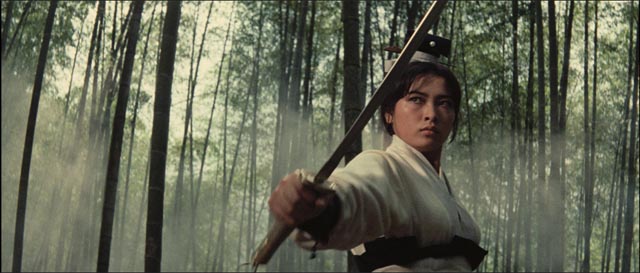
I first came across the films of King Hu when I went to live in Hong Kong for eight months in 1980-81. Someone I met there recommended him highly (she also had a very low opinion of Jackie Chan as representing a debasement of the martial arts genre). Soon after I arrived in Hong Kong, there was a brief retrospective of Hu’s work and I saw three films over a single weekend – Anger, a segment of the omnibus Hsi nou ai le (Four Moods, 1970); Raining in the Mountain (1979), a story about in-fighting for control of a monastery, shot in Korea; and Legend of the Mountain (also 1979), about a young scholar sent to a remote outpost to translate a sutra with great power, who becomes embroiled with various ghostly spirits.
Then in the spring of 1981, there was another retrospective of Hu’s work at the Hong Kong International Film Festival and I got to see what probably stand as his three most influential films: Come Drink With Me, made for Shaw Brothers in 1966, a film which began a transformation of the wuxia genre; the hugely successful Dragon Gate Inn (aka Dragon Inn, 1967), made in Taiwan after Hu’s break with Shaw Brothers; and the epic A Touch of Zen (1971), also made in Taiwan. This last, considered Hu’s masterpiece, was hugely ambitious, very expensive by then current standards, and plagued by conflicts between Hu and his backers, resulting in its being split into two parts, the first released in 1970 before filming was completed, with part two following in 1971. The film was not seen as Hu originally intended until it was reconstructed and screened at Cannes in 1975, where it won a prize for its artistic quality.
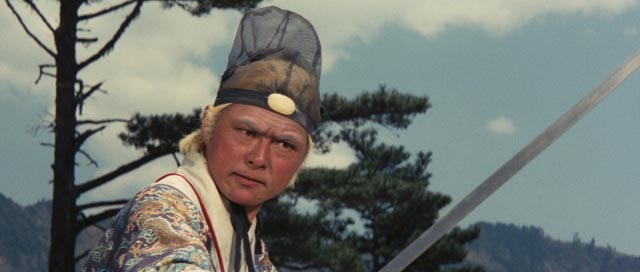
The impact these films had on wuxia was two-fold, both conceptual and stylistic. One of Hu’s most important stylistic innovations was his application of the techniques of Peking Opera to the fight scenes, adding a stylized choreography. This in turn was crucial to his conceptual innovation, transforming films rooted in a realistic attention to historical and social detail into fantasy expressions of the philosophical and spiritual concepts underlying traditional martial arts. After Hu, this became one of the key conceptual elements of martial arts cinema, and perhaps the one most responsible for the genre’s international success. His influence is apparent in such hits as Ang Lee’s Crouching Tiger, Hidden Dragon (2000) and the series of highly stylized martial arts films made by Zhang Yimou in the early 2000s.
As important as the style of Hu’s films is their narrative and thematic content. Set during the late stages of the Ming Dynasty, these films reuse certain elements just as the Hollywood western plays variations on a limited number of themes most often set during the three decades after the Civil War. In Hu’s films, the protagonists tend to be outsiders who become mixed up in intrigues involving struggles for power in the Imperial Court. In both Dragon Gate Inn and A Touch of Zen, key characters are the surviving children of executed officials who have been targeted for elimination by the East Chamber, the secret police who serve the Eunuchs who have appropriated power for themselves at court.
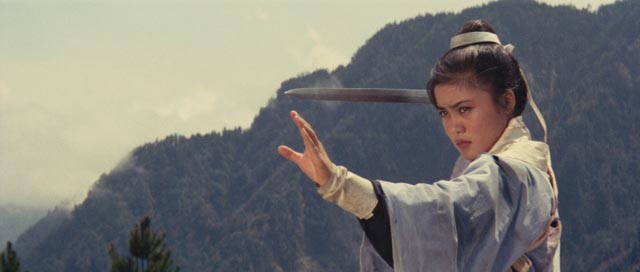
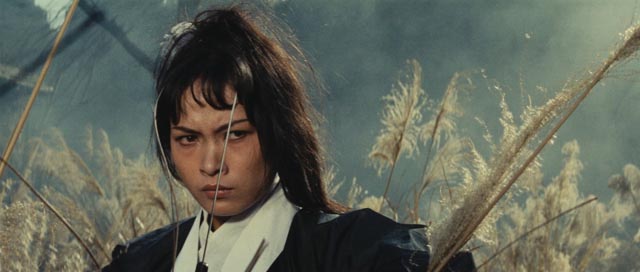
The conflict between political power and spiritual power also runs through the films. In Come Drink With Me, the bandits who have kidnapped a general’s son to force the release of their imprisoned leader are hiding out in a monastery governed by a corrupt abbot. This intersection of the religious and the political/temporal reaches its apotheosis in A Touch of Zen.
For some viewers, Hu’s films may seem slightly dated because we’re now so used to highly elaborate wire-work and the enhancement of fight scenes with CGI. In Hu’s films, the fights make use of such basic devices as trampolines to get the actors airborne, and judicious camera placement and careful editing to enhance the sense of weightlessness. But the carefully constructed narratives and Hu’s ability to create a convincingly detailed context for the action render these supposed “limitations” irrelevant.
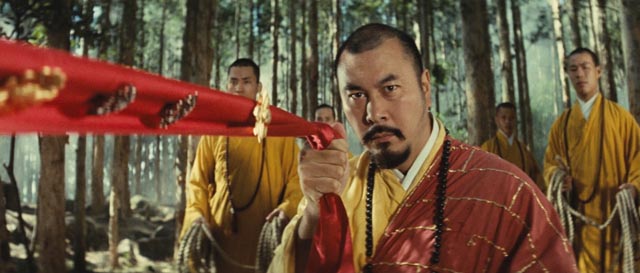
As the many filmmakers who followed Hu built on his innovations, he came to be seen as old-fashioned and by the time of Legend of the Mountain his work was being mocked as ridiculously creaky. One of his greatest acolytes, Tsui Hark, hired Hu to direct The Swordsman in 1990, but the director was unable to give Tsui what he wanted and they parted company, with the film being finished by several other directors. Hu made only one more film, Painted Skin (1993), a determinedly old fashioned fantasy about yet another young scholar who becomes involved with a ghost.
It’s unfortunate that Hu’s later inability to change with the times in terms of production techniques and attitudes has perhaps obscured his early innovations and the great influence he had on many younger Chinese filmmakers. Hopefully his profile will be raised in the English-speaking world by the release of his two most influential films by Eureka in England in dual-format editions from their Masters of Cinema imprint.
*
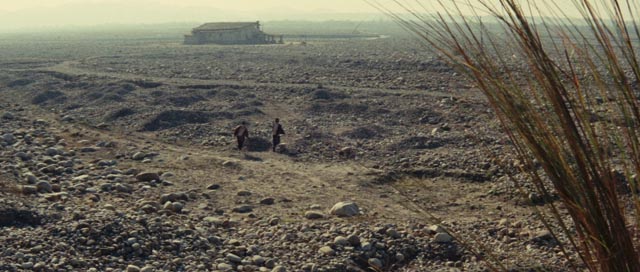
Dragon Inn (1967)
Minister Yu having been killed by the eunuch Cao (Pai Ying), his children are sent into exile in a border region. But Cao will only be satisfied if the entire line is eliminated and so agents of the East Chamber are despatched to lay a trap at Dragon Gate Inn. However, there are still some who are loyal to Yu and they gather to defeat Cao’s forces.
Hu’s previous film, Come Drink With Me, had begun his transformation of the genre but it was still constrained by the traditions of studio filmmaking. The break with Shaw Brothers and the move to Taiwan, which had only a rudimentary production capacity, allowed him to work on a larger canvas, shooting much of the film on location (with possible influences from the spaghetti western, which the film resembles in broad outline). The desert landscapes, allied with Hu’s careful attention to production design (he had previously worked as a designer, as well as an actor), give the film a sense of scale not possible within the confines of a studio.
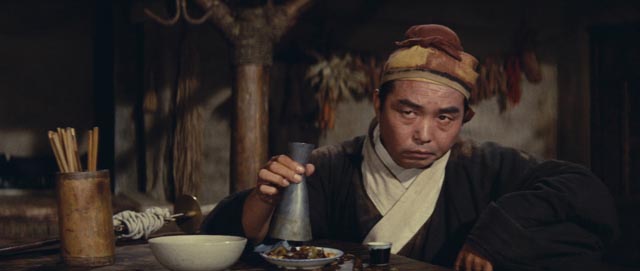
As in Come Drink With Me, however, Hu plays with ambiguities of character, veiled loyalties and conflicts among the various factions which eventually come together for a common cause. The primary elements of the genre are firmly established here – the power-obsessed eunuchs and their secret police, the fearless swordswoman (often mistaken in these films for a man by the other characters, although clearly a woman to the audience – this too perhaps derives from the conventions of Peking Opera), and the endangered family of a murdered loyal official. The film plays as a thriller about factions vying for political power, interspersed with often very impressively choreographed action scenes.
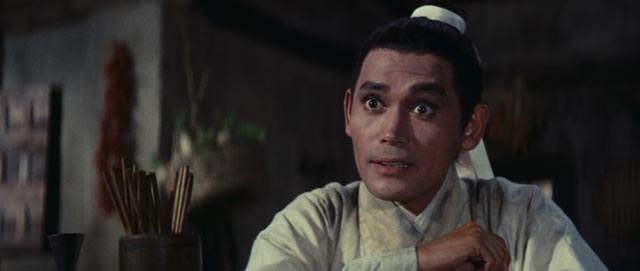
The political element, Hu claimed, was inspired by what he saw as the troubling valourizing of lawless power in popular culture represented by the success of James Bond and similar agents of the state. The secret police of the East Chamber represent the worst excesses of political ambition.
The importance of Dragon Gate Inn as a seminal work in the genre is apparent in at least two direct remakes – Raymond Lee’s Dragon Inn (1992), produced by Tsui Hark, and Tsui’s own Flying Swords of Dragon Gate (2011), made in 3D, with a much pulpier approach to the material – as well as an homage by Tsai Ming-liang, Goodbye, Dragon Inn (2003), which ties the New Taiwan Cinema to an older tradition by setting its minimalist narrative(s) about a small group of people during the final show at an old, and now closing, movie theatre which is screening Hu’s film on a rainy evening.
*
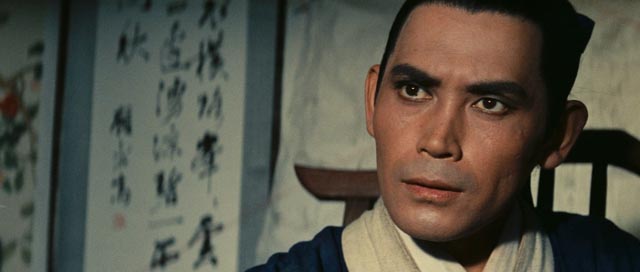
A Touch of Zen (1971/75)
After Dragon Gate Inn, King Hu’s ambition exceeded the limitations of the fledgling Taiwanese film industry. Conceived on an epic scale, combining martial arts action with a conflict between Taoist and Zen principles, the film took several years to make; projected to run something like three hours, it went against industry standards and the director was initially forced to break the structure in two, repeating the famous bamboo forest fight at the end of part one and the start of part two. It was several years before Hu was able to put the pieces back together and present the full film at Cannes in 1975. None of the films which followed managed to achieve the stature of A Touch of Zen, but this film is now considered the masterpiece of the wuxia genre.
And yet a fan of the genre might be frustrated because Hu’s larger purpose results in the swordplay being held off for almost an hour as he carefully lays all the groundwork. In fact, the film falls into three distinct parts, the first focusing on the everyday life of Gu Shengzhai (Shih Jun), an unambitious scholar who lives near an abandoned fort in a small town. Despite the urging of his mother to write the civil service exams, he’s content to have a small booth in the market where he can sketch portraits and sell calligraphy. This early section is visually rich in the details of ordinary life – the town and fort were constructed according to Hu’s own designs and left to stand for a year so that it would appear naturally weathered and the tall grasses planted in the area would grow wild and add an authentic air of age and neglect.
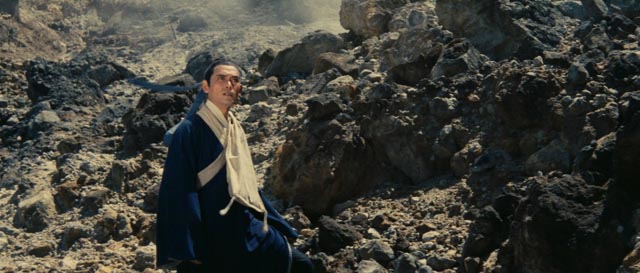
This first section carries hints of the traditional Chinese ghost story. In fact the whole film had its initial inspiration in a very brief story from Pu Songling’s Strange Stories From a Chinese Studio (1679). In Hu’s adaptation the apparently supernatural element is eventually revealed as a misinterpretation of events involving yet another exiled child of a murdered official. Yang Huizhen, imposingly played by Hsu Feng, is hiding out in the fort with her ailing servant. Gu’s mother sees this as an excellent opportunity for Gu to get married, but Yang couldn’t settle down even if she wanted to as the forces of the East Chamber close in. Surprisingly, however, she does spend one night with Gu.
One of the most interesting aspects of A Touch of Zen is that it takes the point of view of Gu, a very unworldly intellectual rather than a martial artist. As Yang’s background gradually emerges, Gu uses his understanding of history to devise a strategy for the very limited forces loyal to Yang, enabling them to combat and defeat far superior opposing forces. Using rumours to stir up superstitions about the haunting of the old fort, combined with various mechanical means, Yang’s allies defeat the East Chamber agents in a battle at night; in the morning aftermath, Gu proudly surveys the success of his strategy – until he sees past his tactics to the bloody results, becoming horrified by the extent of the slaughter.
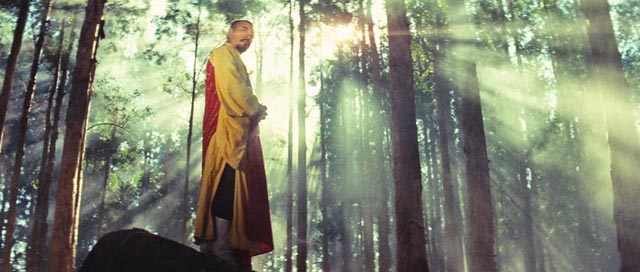
After the battle, Yang and her supporters vanish. This leads to the film’s second movement, featuring the impressive fight in the bamboo forest, a huge influence on many subsequent films with its flying combatants dashing through treetops. (Ang Lee directly references this sequence in Crouching Tiger.) This second act also introduces the group of Buddhist monks lead by Abbot Huiyuan (Roy Chiao), a figure whose power resides in an unshakable stillness. Having intervened between Yang’s group and the pursuing East Chamber forces, Huiyuan leads her to his monastery in the mountains, where Gu finally tracks her down.
Yang comes out to present Gu with the child he fathered, telling him that there can be no further connection between them. But the enemy finds Gu and the child, and Yang and Huiyuan emerge from the monastery again for the final fight against the eunuch. Here the film becomes almost abstract, moving beyond politics to the spiritual realm, its final fight seeming to take place on another plane. This is a battle between darkness and light, leading eventually to a suggestion of enlightenment (“a touch of zen”) … completing the narrative’s trajectory from the quotidian through the political to the spiritual. This is definitely not the norm for a martial arts genre film and few if any filmmakers who came after King Hu pushed their work to this thematic level, leaving A Touch of Zen perhaps to stand alone as the artistic pinnacle of the genre.
*
After watching these new Blu-ray editions of Dragon Gate Inn and A Touch of Zen, I went back to an older DVD of Come Drink With Me. That film holds up very well as a more conventional genre piece, closer to the wuxia mainstream, tightly structured, with impressively staged fight scenes and a strong central female character who points the way to the powerful women at the heart of the two subsequent films.
*
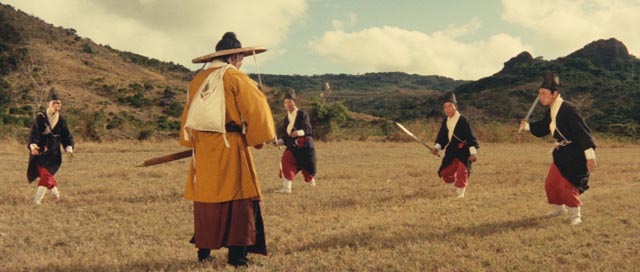
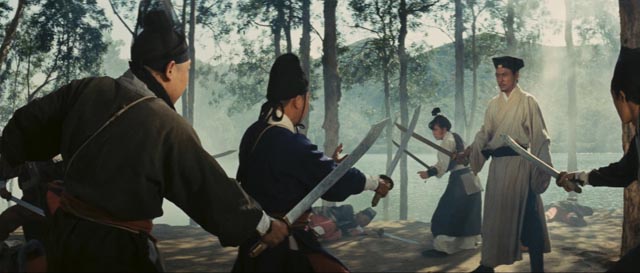
Both these Masters of Cinema releases look wonderful, featuring restorations commissioned by the Taiwanese Ministry of Culture. Both feature video essays by David Cairns, who examines the films’ context and Hu’s stylistic innovations. Additionally, A Touch of Zen features an informative 48-minute documentary about King Hu on a supplementary DVD, as well as a selective commentary track by critic Tony Rayns (which covers some 83-minutes of the film). Each release also contains a booklet with essays, brief surveys of characteristic tropes in Hu’s films, and with A Touch of Zen an interview with Hu, a reprint of his director’s statement from Cannes, and Pu Songling’s short story The Magnanimous Girl, which served as the springboard for Hu’s script.
For a filmmaker of such importance and far-reaching influence, King Hu remains too little known even among fans of wuxia. Eureka has provided a valuable service in releasing these two key works in such impressive editions.
Comments
Not only did I like the choreography of Dragon Inn, I really enjoyed the cinematography, the shot composition, and the colours. It’s really beautiful to look at. Unfortunately, I’ve only seen A Touch of Zen with Mandarin Chinese subtitles, so I’m still pretty much convinced it’s the story of poor innkeepers being pressured by a wealthy land baron and maybe a subplot with some monks, a baby, and a flying girl.
Reminds me of the time I first saw Godard’s Prenom: Carmen in 1984. It was in Munich and the film was either dubbed in German or in French with German subtitles. Either way, I didn’t know the language and I found the film hilariously entertaining. Later, when I saw it again in Winnipeg in French with English subtitles, it seemed rather dull and ordinary. Whatever my brain was doing to make sense of the on-screen events in Munich conjured up something much stranger than the actual story.